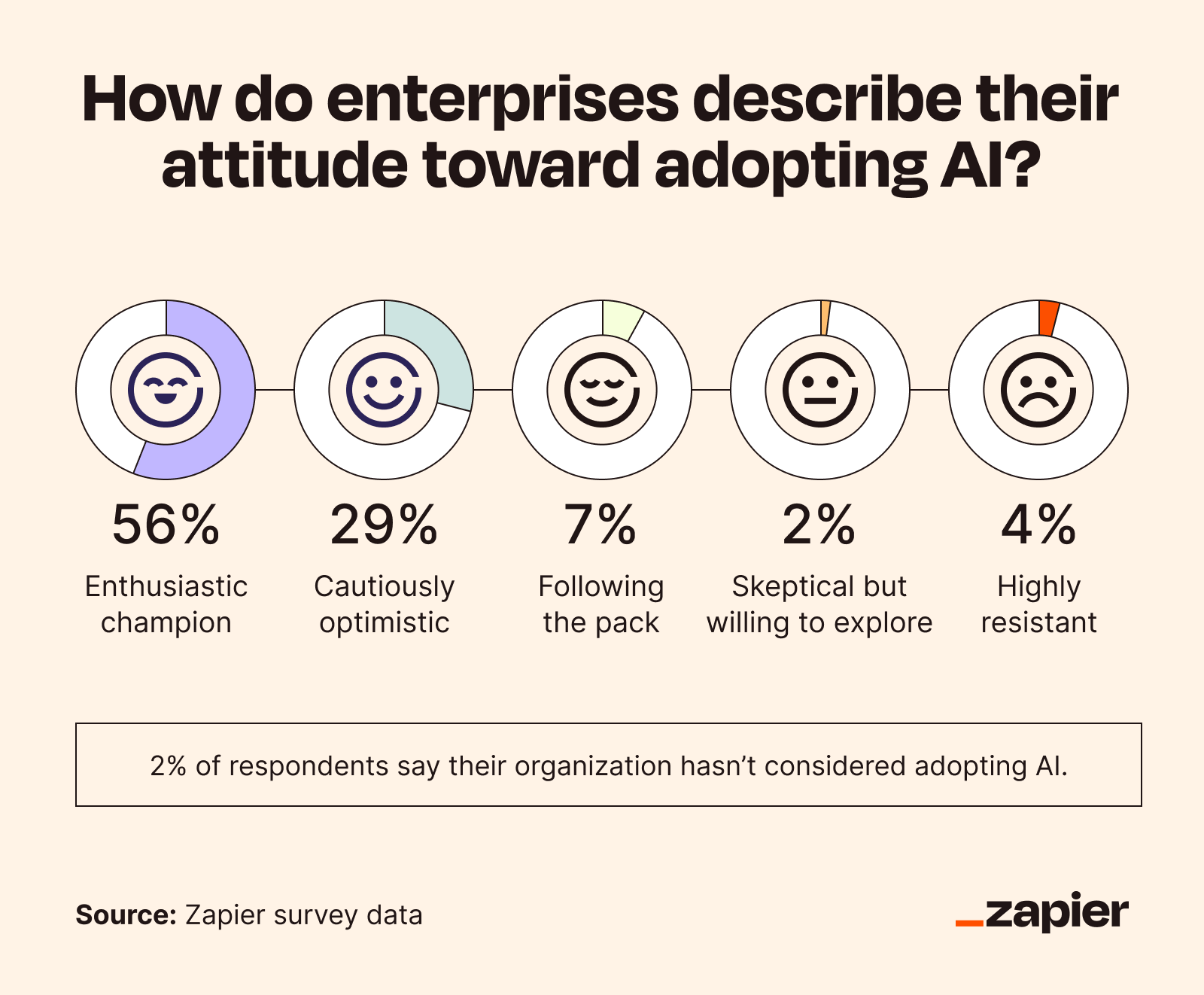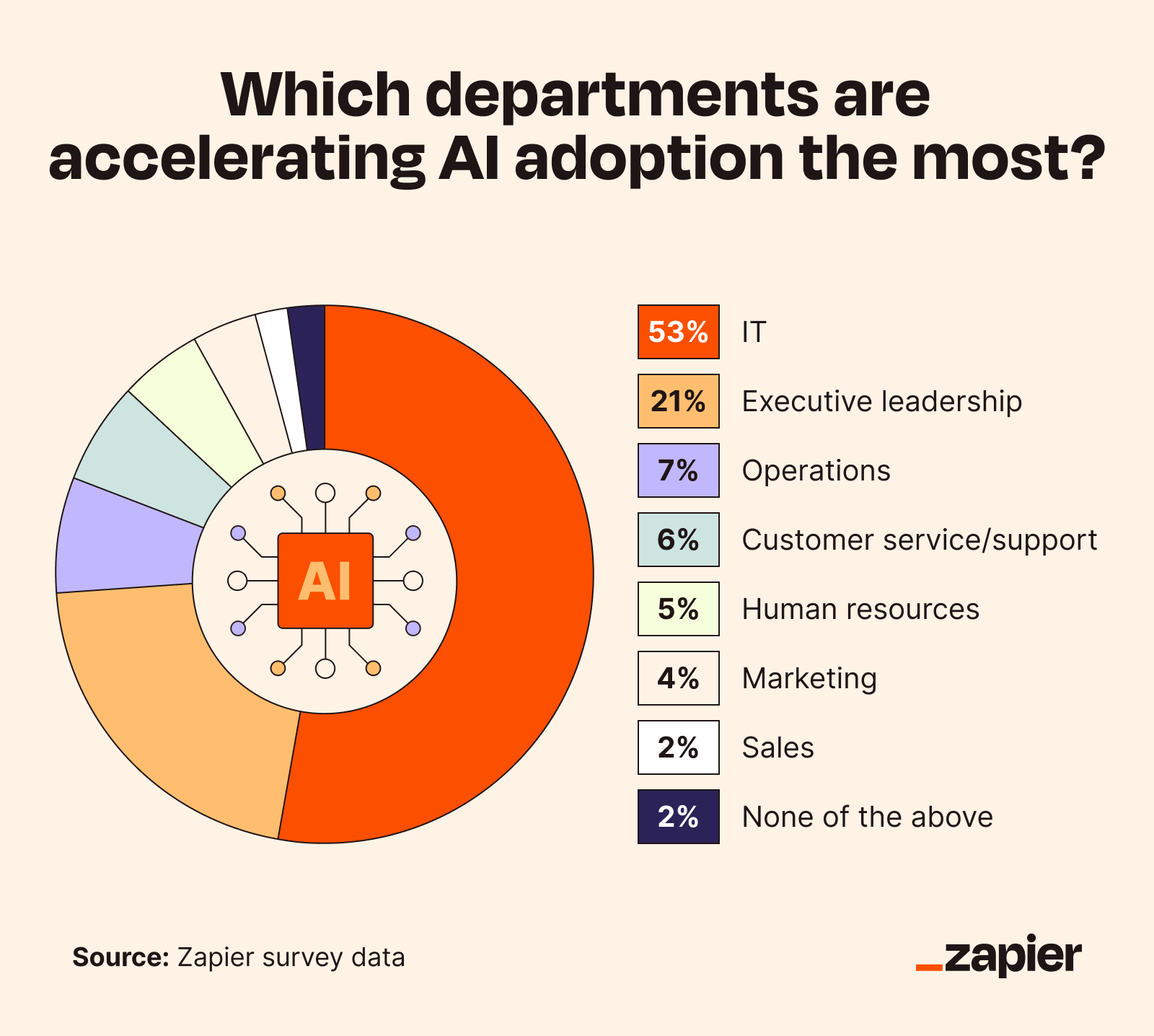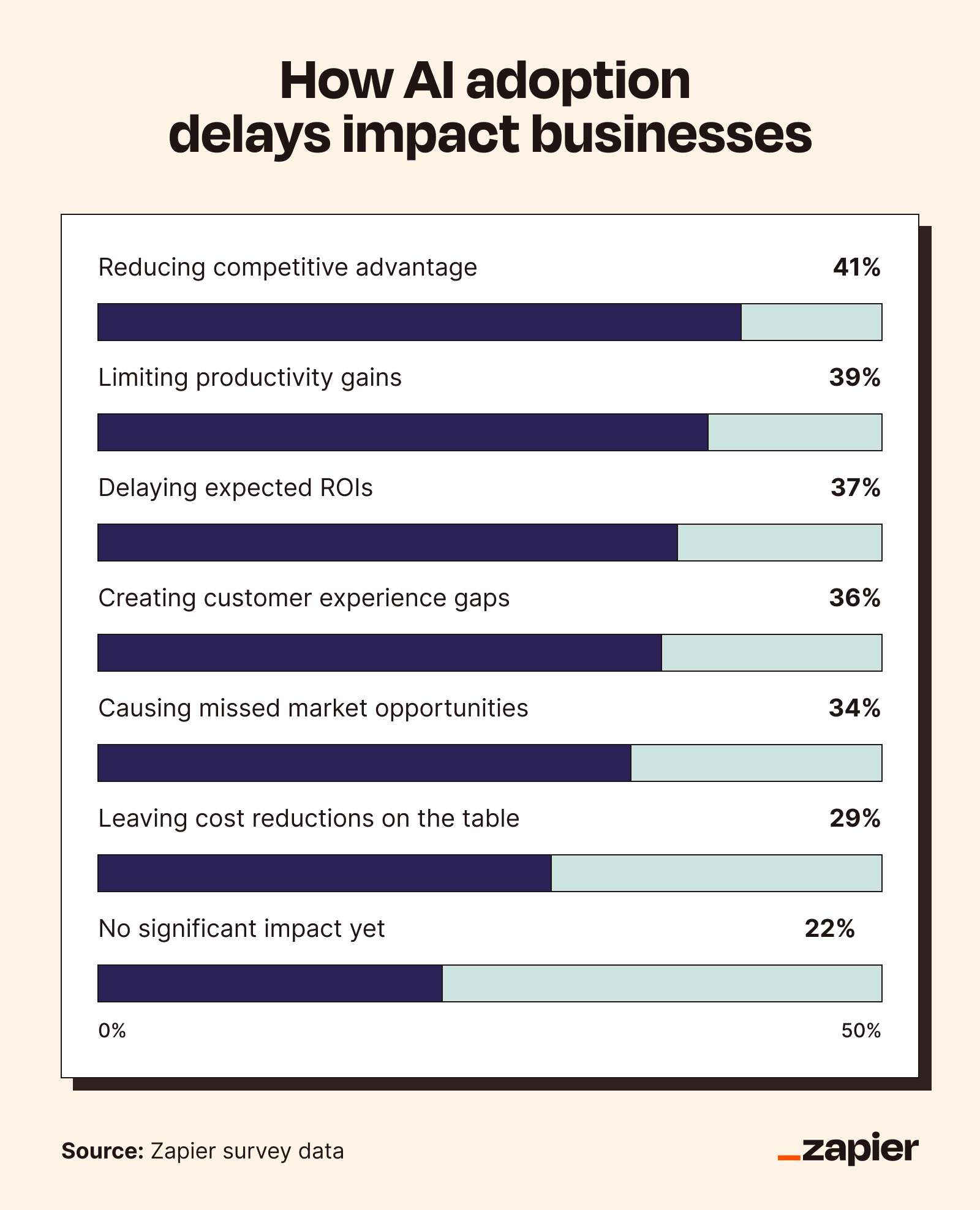In my experience, consumer-facing AI models only scratch the surface of what paid, enterprise-level tools are capable of. But it’s also true that enterprises have a harder time pulling value from AI than the guy who uses it to make SpongeBob meet Peter Griffin for happy hour at Cheers.
AI can dramatically transform an enterprise—it’s just not always easy. Zapier data shows that most businesses are still hitting roadblocks when integrating AI with their existing systems, while high costs, vendor lock-in, and AI skill gaps create further challenges.
To find out what’s slowing AI adoption, Zapier surveyed over 500 enterprise leaders from a range of industries on their attitudes and concerns about artificial intelligence and its impact.
Key findings
-
Over half of enterprise leaders (56%) consider themselves enthusiastic champions of AI adoption.
-
More than 3 in 4 enterprises (78%) are struggling to integrate AI with their existing systems.
-
IT is over 10x more likely to lead AI acceleration than sales, marketing, HR, and customer service teams.
-
Over 4 in 5 companies (81%) feel peer pressure from competitors to speed up AI adoption.
-
Nearly half of enterprise leaders (45%) say the high cost of vendor solutions is a key barrier to AI adoption.
Table of contents:
The majority of enterprises are enthusiastic champions of AI
If I had a dollar for every time I saw AI mentioned while scrolling LinkedIn, I wouldn’t be scrolling LinkedIn—because I’d be too busy spending my newfound riches. This technology is the business world’s Current Big Thing, and 92% of enterprises are now treating AI as a priority.
It’s not a low priority, either: Over half of enterprise leaders (56%) consider themselves enthusiastic champions of AI adoption, which means they see it as critical to their business strategy. Another 28% say they’re cautiously optimistic about AI, moving slowly to ensure ROI and mitigate risks.

On the other end of the spectrum, just 4% of enterprises are actively resistant to adopting AI, and only 2% say they haven’t considered implementing AI at all. So, while not every business can match Zapier’s 97% AI adoption rate, most are heading in that direction.
Integration problems, skill gaps, and data quality issues are stalling AI adoption
As important as AI is to most businesses, implementing it at the enterprise level is a bit trickier than getting ChatGPT to plan your trip to Cabo. You need leadership buy-in, IT approval, security and governance frameworks, and (of course) funds to invest in AI tools. You also want to ensure those tools connect with your current tech stack, which isn’t a given.
Close to a third of enterprise leaders (29%) see integrating AI with existing systems as a top barrier to AI adoption, and nearly 4 in 5 (78%) indicated that they’re struggling to integrate AI with their existing systems.
Other barriers to adoption include AI skill gaps among employees (35%), data quality issues (29%), and IT infrastructure bottlenecks (27%).
Zapier, the most connected AI orchestration platform, can help you get over the AI integration gap. With more than 8,000 integrations across the tools you already use, Zapier can bring AI to all your workflows and set you up for a future where enterprise-wide AI is a must instead of a “nice to have.”
IT and the C-suite are AI’s biggest promoters—but also its biggest bottlenecks
When it comes to pushing AI in the enterprise, IT is way ahead of any other department. Over half of enterprise leaders (53%) say IT teams are accelerating AI adoption the most at their companies, while executives come in a distant second place at 21%.
Overall, IT is over 10x more likely to lead AI acceleration than sales, marketing, HR, and customer service teams. While we might expect to see a tech-focused department push hardest for AI, this data shows how big the gaps between teams really are.

But there’s a paradox at play here, since business leaders also say IT and the C-suite are the departments most likely to slow AI adoption. For IT, this is likely because infrastructure limitations and approval processes for AI tools lead to bottlenecks in implementation. For the C-suite, well, budgets, stakeholders, and ROIs are a thing.
At the same time, just 13% of enterprises have yet to secure leadership buy-in on AI. This means the roadblock isn’t whether to adopt AI, but how fast the organization can move once everyone agrees it needs to happen.
If your leadership is on board but you’re worried about handing the AI reins to non-technical users, Zapier’s no-code approach to AI automation can help. It lets business teams build and orchestrate workflows without sacrificing security and governance or having to ping IT for every minor tweak.
4 in 5 businesses feel pressure from competitors to accelerate AI adoption
Peer pressure might make you think of a group of teens chanting “Do it, do it, do it,” but it’s a thing outside of high school, too. In business, it’s led 81% of companies to feel they need to speed up AI adoption to keep pace with competitors in their industry.
Of this group, about half (48%) rate AI peer pressure as moderate, while 1 in 3 (33%) rate it as high. Another 15% say the pressure’s low but still present, and only 5% feel no pressure at all.
Not being able to keep up has consequences: 41% of leaders say slow AI rollouts have made them fall behind their competition, and 39% claim they’ve missed out on productivity gains due to AI adoption snags. Further impacts include delayed ROIs (37%), customer experience gaps (36%), and missed market opportunities (34%).

To keep pace with your industry, you can use Zapier to integrate AI at the enterprise level without getting bogged down by IT bottlenecks or clashes with existing software. Start thinking about AI adoption on the scale of days rather than months, and catch up to the competition by orchestrating AI tools and agents across over 8,000 apps.
AI vendor costs, security, and lock-in are top concerns
AI apps have exploded in number, and now there are about as many to choose from as there were NFTs in 2021. Unlike NFTs, AI is here to stay, but as enterprises search for tools that match their needs, they face some notable challenges.
The top barrier noted by enterprise leaders (45%) is the high cost of vendor solutions—because the more you spend on an AI tool, the more value it has to bring to the table to prove its ROI.
On top of this, 38% say they lack trust in AI vendor security, while another third (33%) fear vendor lock-in—becoming overly dependent on a single vendor’s AI systems. And nearly a quarter of enterprise leaders (23%) say AI tools don’t integrate with their existing systems, greatly increasing the risk of lock-in.
Zapier helps enterprises mitigate these risks by offering a flexible, vendor-agnostic automation platform. With Zapier, you can connect AI tools from multiple vendors without committing to a single ecosystem—maintaining control over your data, workflows, and costs. Zapier’s enterprise-grade security ensures compliance and governance across every integration, while its no-code environment empowers teams to experiment with AI safely and affordably, scaling only what delivers measurable ROI.
Bring AI to the enterprise with Zapier
You won’t be bound to a single vendor if the AI tools in your tech stack connect with each other. With Zapier, you can integrate thousands of apps and start building automated AI workflows across your enterprise without hitting IT bottlenecks.
Zapier keeps your tools out of silos and lets you orchestrate AI as part of unified, company-wide business processes. Democratize AI by making it accessible to team members regardless of their technical background, all while maintaining IT oversight for compliance and security.
Cut down on tool sprawl by leveraging Zapier’s built-in AI Copilot, Agents, Chabots, MCP, and templates. And when you do need to go third party, Zapier can integrate and automate all the top AI apps.
Methodology
The survey was conducted by Centiment for Zapier between September 19 and September 23, 2025. The results are based on 532 completed surveys. In order to qualify, respondents were screened to be U.S. C-Suite Executives, Presidents, Owners, or Partners at companies with 1000+ employees. Data is unweighted, and the margin of error is approximately +/-4% for the overall sample with a 95% confidence level.
Related reading: